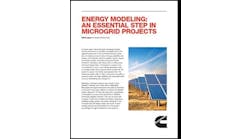In this video interview from Microgrid 2017 in Boston, Doug Staker of Demand Energy Networks, discusses the potential of solar plus storage — and how it can boost resiliency — with Microgrid Knowledge chief editor Elisa Wood.
Do you think solar plus storage is still too expensive to use in commercial projects? Consider what Doug Staker, vice president of global business development at Demand Energy Networks, had to say at Microgrid 2017, held November 6-8 in Boston.
Staker sheds light on where — and why — this simply isn’t the case anymore.
The installed levelized cost of commercial solar has fallen significantly, allowing Demand Energy to offer power purchase agreements (PPAs) in the 7 to 9 cent/kWh range.
As a result, the cost proposition plays out well in markets “where there are challenges with demand charge management, demand response, and even resiliency,” Staker said.
Solar proves to be a particularly good option in places like New York, New England, California and Hawaii, where electricity prices are high.
But Staker sees opportunities emerging in other regions as well. Examples are South Africa and Australia.
As for the benefits of combining solar and storage, think of solar as “a great source of inexpensive energy, but as a terrible source of power,” Staker said. Marrying solar with a battery changes that.
[clickToTweet tweet=”What makes sense about combining solar and storage is the potential for increased resiliency. #microgrids” quote=”What makes sense about combining solar and storage is the potential for increased resiliency. #microgrids”]
Companies that are trying to manage demand charges can use solar plus storage to time-shift and accommodate peak loads for bill savings. They may also time shift for grid support via a demand response program.
Solar plus storage makes particular sense for customers seeking resiliency, according to Staker. This is especially true in light of this year’s difficult hurricane season.
The combination of solar plus storage makes sense “especially in areas that are susceptible to outages via storm activity, be that ice storms or hurricanes, or earthquakes. Now you can take that solar resource, transform that into a firm resource, and provide resiliency.” —Doug Staker, vice president of global business development at Demand Energy Networks
Often standalone solar systems need the grid for voltage support. If the solar energy system is matched with a storage system that has a voltage source inverter, “now you can energize that solar and make it active in a standalone mode for resiliency,” Staker said.
Microgrid 2017 was sold out! Register now for Microgrid 2018 in Chicago.
Doug Staker is vice president of global business development at Demand Energy Networks.







